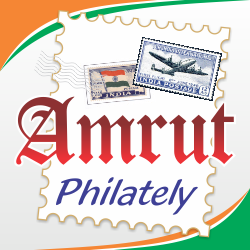Adhesive – A gummed stamp
Albino - A design impression without colour
Aniline – A fugitive (water soluble) ink or dye
Bisect – Part of a stamp that has been cut in two for separate use; usually during a shortage of stamps
Blind perforation – A perforation which has not been punched out
Block – A group of four or more unseparated stamps
Bogus – A spurious, pretend stamp
Booklet – A small book containing ‘panes’ of stamps
Booklet pane – A leaf or page of stamps from a booklet
Cachet – A commemorative marking, usually applied by rubber stamp
Cancellation – Any authorised defacing mark on a stamp
Centre – The position of a stamp design within its perforations, e.g. ‘well-centred’ or ‘off-centre’
Chalky paper – Stamp paper coated with a chalky solution for security purposes. Attempted removal of the postmark damages the surface of the stamp
Charity stamp – One bearing a premium or surcharge for charitable purposes
Classic – A country’s early stamp issues, mostly up to about 1875; a choice stamp
Coil stamp – One from a roll of stamps used in vending machines
Coil join – A tab uniting two sections of a roll of stamps
Comb perforation – Perforation in which the perforation pins are arranged in a comb pattern so that three sides of a stamp are perforated at one stroke
Commemorative – A stamp issued to mark a special anniversary or event
Country stamp – See Regional
Cover – A postally used envelope, letter-sheet or wrapper
Cylinder number – Letters/numerals in sheet margins identifying printing cylinders. Normally collected in ‘Cylinder block’ of six stamps. Also see ‘Plate number’
Die – An engraved plate for impressing design etc. on softer metal
Doctor blade – A steel blade which removes surplus ink from the printing cylinder in the press
Embossing – A form of printing in relief
Error – A mistake in stamp design, printing or production
Essay – A trial stamp design, sometimes differing from the issued stamps
Face value – The denomination of a stamp, expressed on its face
Fake – A genuine stamp doctored in some way to deceive collectors
First Day Cover – A cover bearing stamps postmarked on their day of issue
Flaw – A fortuitous blemish on a stamp; a printing fault
Forgery – A fraudulent copy of a genuine postage stamp, overprint or postmark
Frama stamps – See machine label
Graphite lines – Black vertical lines printed on the back of GB definitives, 1957–1959, for use with automatic letter-sorting equipment. Also see ‘Phosphor’ stamps
Greetings stamp – Stamp intended for use on birthday or other greetings mail
Gum Mucilage – on the back of adhesive stamps. Not ‘glue’
Gutter – The narrow space between stamps in the sheet permitting perforation
Gutter margin – The blank margins dividing a sheet of stamps into panes
Handstamp – A postmark or overprint applied by hand
Imperforate Stamps – printed and issued without perforations, deliberately or in error
Imprint – The name of the printer or issuing authority inscribed on the stamps or in the sheet margins
Imprinted stamps – Stamps other than adhesives, printed direct on postal stationery items (postcards, envelopes, etc)
‘Invert’ – The central design (‘vignette’) or portion of a stamp printed upside-down in relation to the frame, or vice versa
Jubilee Line – Coloured line found in the sheet margin of British stamps
Key type – Uniform design used by many colonial empires, a standard key, or head, plate being used with different duty plates bearing country name and value
Line perforation – Perforation of a sheet of stamps by a single line or row of holes – the simplest form of perforation
‘Machin’ – The name given to GB definitives, first issued in 1967, bearing the Queen’s head designed by Arnold Machin
Machine label – Postage stamp produced by a micro-processor machine after insertion of coins of the required value, popularly known as Frama stamps
Maltese Cross – Name given to the cross-shaped cancellation used on the first British stamps
Margin – The unprinted edging surrounding or dividing a sheet of stamps. See also ‘Gutter margin’
Maximum card – A picture postcard bearing a stamp and cancellation relevant to the picture on the card
Miniature sheet – A small sheet of one or several stamps, usually with decorative
Perforations Holes – punched between stamps in sheets to enable easy separation
Personalised stamp – Stamp with an attached non postal label bearing an image taken from a personal photograph
Phosphor stamps – Stamps overprinted or coated with phosphorescent materials recognised by high technology letter sorting machinery
Plate number - Letters/numerals in sheet margins identifying printing plates. Also see ‘Cylinder number’
Postmark – Any mark, such as a cancellation, connected with the postal service and found on items transmitted by post
Pre-cancel – Stamp intended for use by a bulk poster and supplied with a pre-printed cancellation
Presentation pack – A philatelic souvenir containing a set of stamps and descriptive text
Prestige booklet – Stamp booklet devoted to a particular subject or event and containing special panes of stamps with descriptive text printed alongside
Proof – A trial impression taken from an original die or printing plate
Provisional – A stamp, usually overprinted or surcharged, issued for temporary use margins, issued as a souvenir for collectors
Mint – A stamp in its original pristine state, with full gum (if so issued), when it is said to have its ‘original gum’ (‘O.G.’). ‘Unmounted mint’ stamps have not been hinged. Also see ‘Unused’
Mulready – Envelopes and letter sheets issued by Britain in 1840 with a pictorial motif designed by William Mulready
Non Value Indicator stamp (NVI) – A stamp which bears no monetary inscription, but shows the class of postage (1st, 2nd) instead
Obsolete – A stamp no longer sold by a post office though it may still be valid for postage
Overprint – A printed addition to a stamp. Also see ‘Surcharge’
Pair Two – unseparated stamps, joined as originally issued
Pane – A formation or group of stamps within the sheet. Also see ‘Booklet pane’
Regional Name – given by collectors to stamps issued by Royal Mail (who term them Country stamps) for use in England, Scotland, Wales or Northern Ireland. Issues were also made for Guernsey and Jersey (until 1969) and the Isle of Man (until 1973)
Remainders Stamps – remaining in official stocks after becoming obsolete
Reprints Stamps – printed anew after being withdrawn. The printing of additional supplies of current stamps is best described as ‘new printings’
Roulette Stamps – separated by a series of cuts instead of perforations
Seahorse Name – given to the high value definitive stamps of King George V
Self-adhesive Gummed – stamps (with protective backing) which do not require moistening
Se-tenant – Stamps of different design or face value that are joined together
Specimen Sample – stamp usually with ‘specimen’ overprinted or perforated on it
Strip – Three or more stamps joined in a row
Surcharge – An overprint which specifically changes a stamp’s face value
Tête-bêche – A stamp inverted in relation to the adjoining stamp in a pair
Traffic lights – Collectors’ term for the colour check dots found in sheet margins
Unused – An uncancelled stamp, not necessarily ‘mint’
Used – A stamp which has been postally used and appropriately postmarked
Used abroad – Stamps of one country used and postmarked in another
Used on piece – Stamp kept on part of the original cover to preserve the complete postmark
Variety – A stamp differing in some detail from the normal issue
Vignette – The central portion of a stamp design, printed separately within the frame; strictly one which shades off at its edges
Watermark – A distinctive device or emblem in stamps, formed by ‘thinning’ of the paper during production. A watermark is normally viewed through the front of the stamp
‘Wilding’ – The name given to British definitive stamps, first issued in 1952, bearing the Queen’s head from a photographic portrait by Dorothy Wilding
Wing margin – Wide margin on one side of a stamp caused by central perforation of the sheet gutter margin



ABOUT US